Social Media in 2010 and the Rise of Social Referrers
By mid-2010, social referrers like Facebook, Digg and StumbleUpon are a key driver for our tech blog’s traffic. Meanwhile, we hire a new community manager and discuss how best to use Twitter.
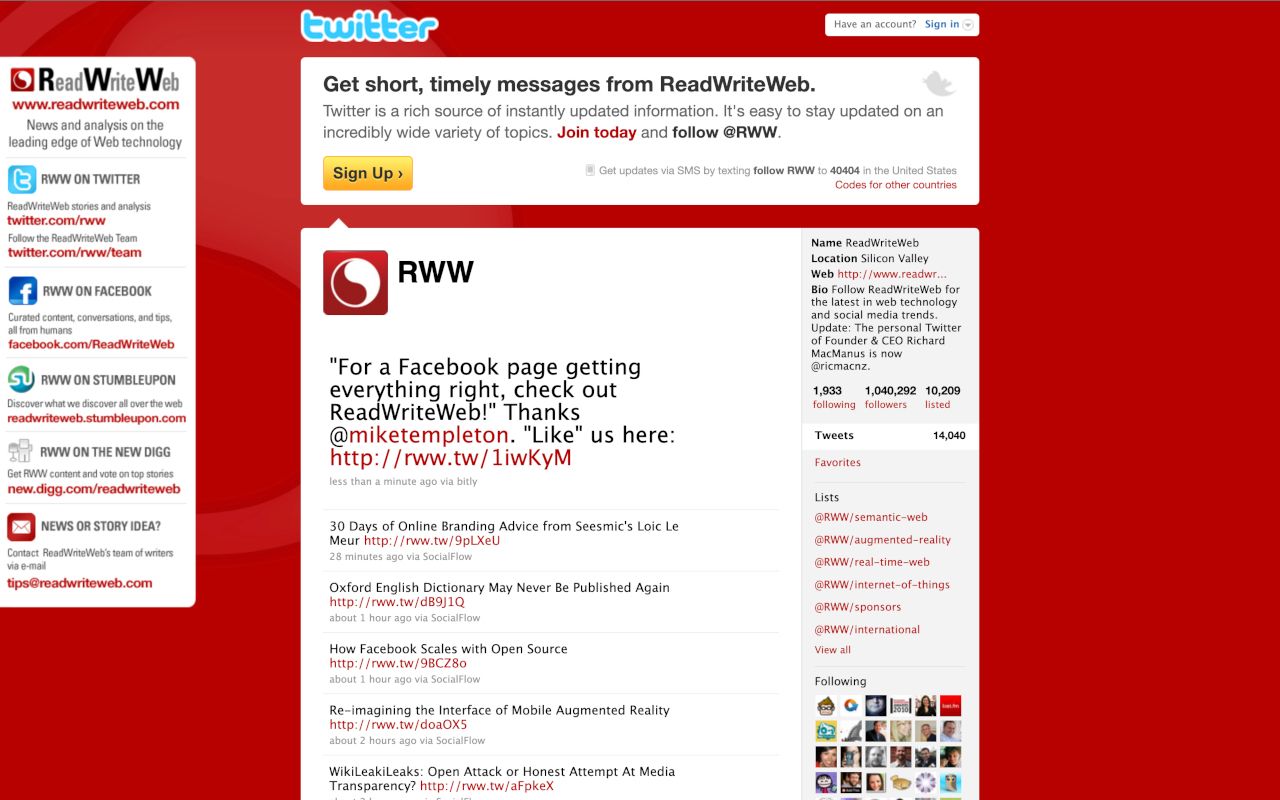
In July 2010 we finally began the process of advertising for a new community manager, after Jolie’s departure in March. We wanted someone who was an active user of social media tools and who had experience managing online communities. Ideally, we were looking for someone based in Silicon Valley, but since we’d had trouble getting writers who met that criterion, we figured that might be the case for the CM role too.
I wrote a post on ReadWriteWeb stating that we were looking for a new community manager. This got a great response, garnering more than a hundred applicants. I narrowed it down to ten and then to a shortlist of four. A couple of them were based in the Seattle area, one in Chicago, and the other in New Jersey—we went none for four on the Silicon Valley ask. Nevertheless, I proceeded to the interview stage confident we’d be able to hire someone decent.
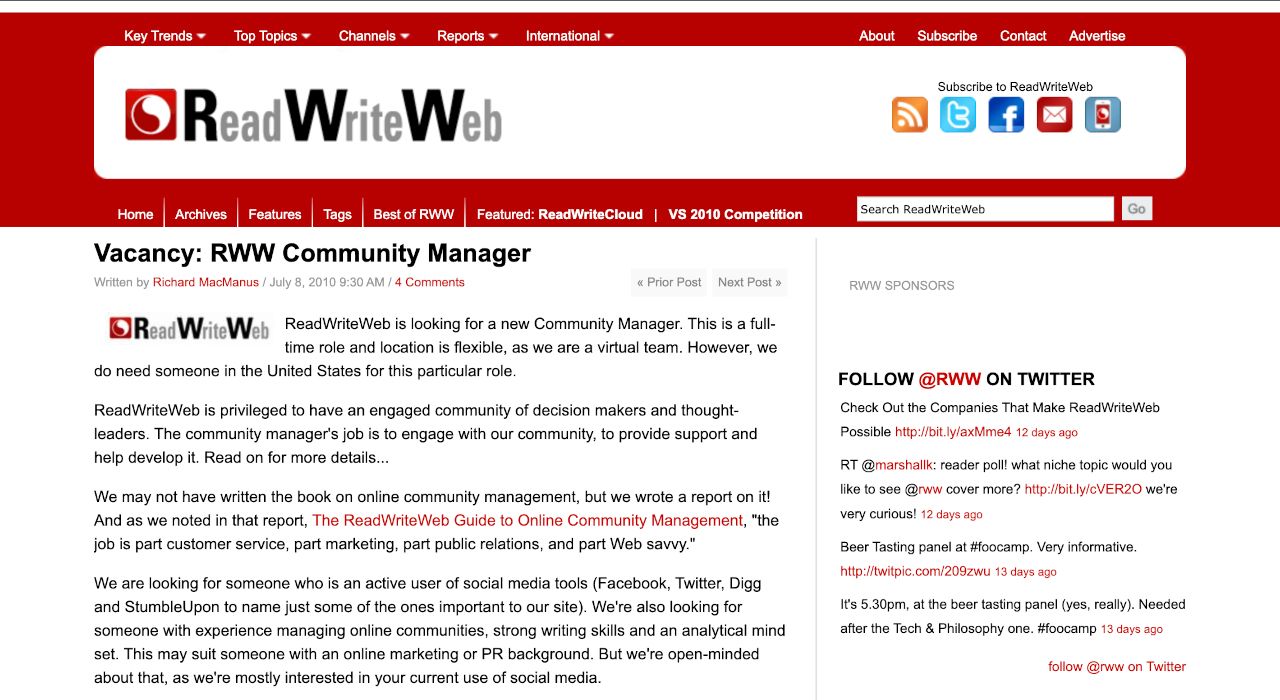
The applicant from New Jersey, Seamus Condron, was our early favorite—purely based on his résumé and email pitch. He’d been community manager at the media publication Mediabistro for over three years and was currently consulting for Hearst Digital Media. By comparison, the three other shortlisted applicants either lacked experience in a CM role or hadn’t worked in media. Seamus seemed to cover both bases.
Our main concern was his salary expectation, which was reasonable but still beyond what we’d budgeted for. Sean noted, “Our budget is razor thin at the moment” and suggested that if we chose Seamus, we might have to start him half-time in the role.
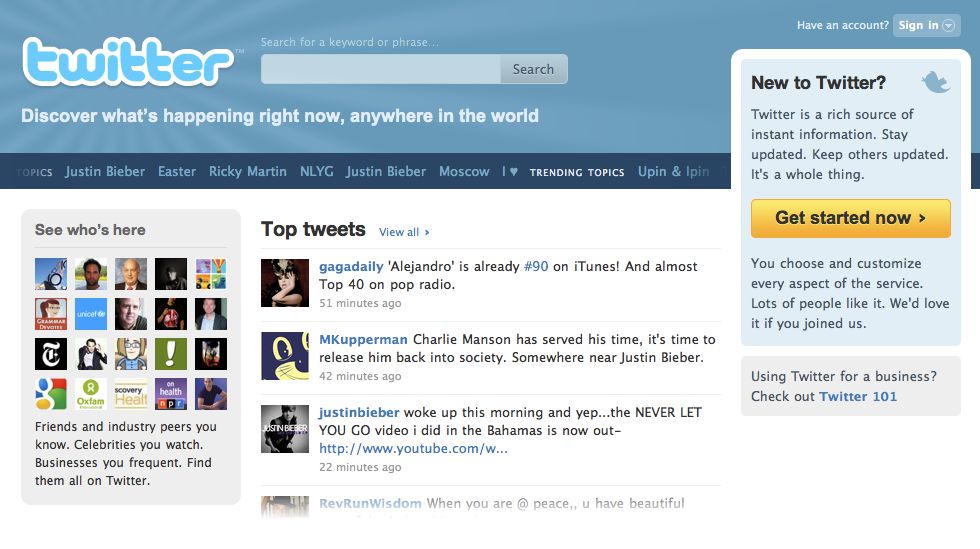
Part of the reason for our tight budget was that we’d had money set aside for the past two months for Frederic to come on as a full-time writer. However, we still hadn’t gotten a decision from him about it. I’d first made the offer to Frederic in the last week of May. Initially he wanted to discuss it with his wife, who was traveling at the time, and he promised to give me an answer by the end of the month. But that date came and went without a decision. I followed up in early June, but this time Frederic said he was busy with his PhD dissertation. I didn’t want to push further, as for some reason he seemed to be getting stressed out by my emails, so I put the matter to one side.
But it was now late July and we still didn’t have an answer from Frederic. So I made the decision to use the portion of the budget we’d set aside for him to make the CM role a full-time one. “We still want to bring you on full-time,” I assured Frederic, “but we understand that getting over those final hurdles for your PhD is your top priority at this stage. Likewise, we have to prioritize what is best for the business and right now we need to allocate budget to the new CM role.”

Sean, Marshall, and I did a video call with Seamus over Skype. He appeared to be in his late twenties and was a heavyset guy with glasses. He’d obviously done his homework, because he gave us all the right answers. In my notes from the call, I jotted down that he was “passionate about media in general” and “big on human interaction and engagement when it comes to community management.” The only thing we could nitpick was that he didn’t use Digg, which was one of the social networks that drove the most traffic to RWW. But compared to the other candidates around his age or younger, and given our budget, Seamus seemed like the best bet. So we offered him the job and he accepted.
Social Media’s Tipping Point
When Seamus started with us, in August 2010, social media was already an integral part of a professional blog business. It was also approaching a tipping point in mainstream culture. Facebook had just passed five hundred million active users in July, so it was already incredibly popular (my mum joined Facebook that very month, and Dad followed in August). Also, although we didn’t know it then, Mark Zuckerberg and Facebook were about to be immortalized in the culture with the Hollywood film The Social Network, which would be released in September.
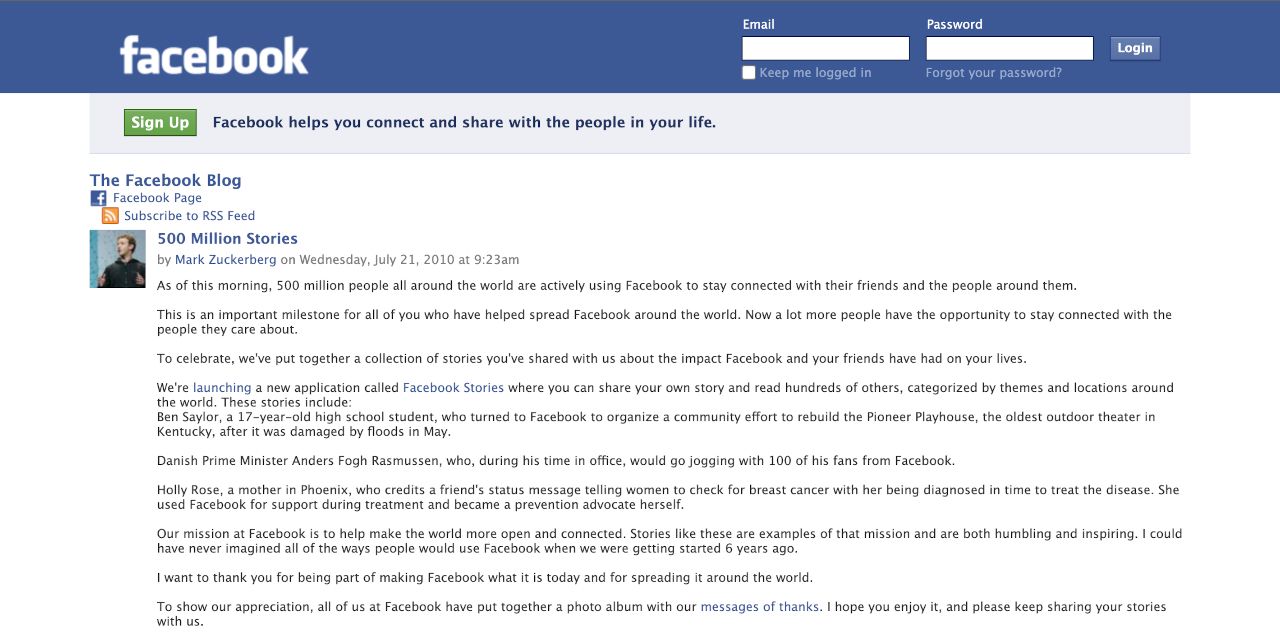
The mainstreaming of Twitter was more complicated. In September I wrote about Twitter’s redesign of its home page. I noted that the new Twitter.com was designed to make it easier for non-tech people to consume content on Twitter. “You don’t have to tweet,” then Twitter CEO Evan Williams said at a press gathering, “any more than you have to make a webpage to use the Web.” A fair statement, but my mum and dad would not be visiting Twitter any time soon (as far as I know, they still haven’t).
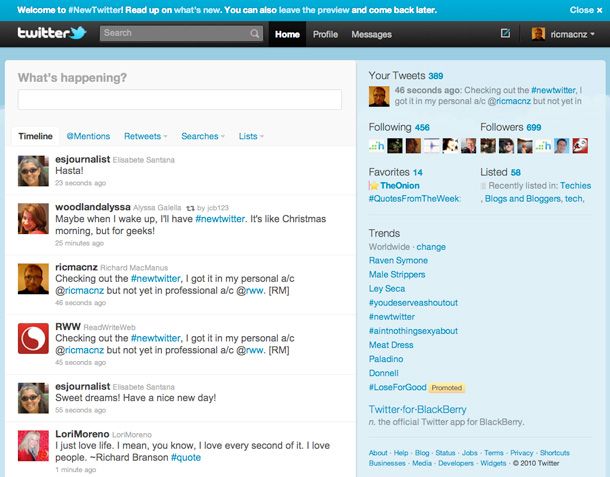
It wasn’t just normal people who were struggling to understand Twitter, though. How to separate the professional from the personal on Twitter was a big topic of discussion among the tech community that year. One line of thinking was that Twitter would follow the same pattern as blogs, going from personal to professional. After all, that’s what happened with RWW, TechCrunch, Mashable, GigaOm, and all the other top tech blogs. But others thought Twitter should always be personal, since it was a conversational medium.
Part of the confusion was that Twitter was fast encroaching onto blogger territory; it was becoming a viable publishing medium in its own right. I did an interview in January with Darren Rowse of ProBlogger in which we discussed this phenomenon. Darren said he’d noticed “a change in the environment,” whereby people were increasingly sharing links on Twitter rather than on blogs. I concurred, saying that I’d noticed more people linking to our stories using Twitter rather than by providing a trackback link from their blogs—a big change from when I’d first started blogging in 2003. But I also said it had widened our audience, too. “It has brought a lot more people into the ‘write’ aspect of the read/write web,” I noted, “because they’re able to contribute to the web without having their own blogs.”

How to use Twitter was a hot topic internally, as well. Some of my team thought the @rww Twitter account should be more “professional,” while others wanted me to keep it personal. Early in the year, one of our readers had written in to complain about my photo being used as the avatar for @rww. I admitted that I had been thinking about reverting to the RWW yin-yang logo, which I’d used when I first joined Twitter in 2007. One RWWer pointed out that people liked faces and that “logos are not personal.” Marshall, who was probably the most effective Twitter user of all of us, thought that RWW was a “news brand” now and so it would look more professional to use our logo. “Faces are good for marketing or customer service, but I think people are subscribing to a news publisher in @rww,” he said.
One of the team suggested I use a separate Twitter account for personal stuff. In fact, I had already started a new account (@ricmacnz) in January with that in mind, but I hadn’t fully committed to the idea of running two separate accounts. It almost felt schizophrenic—RWW was such a big part of my identity now, so why would I want to divide my online persona into two?
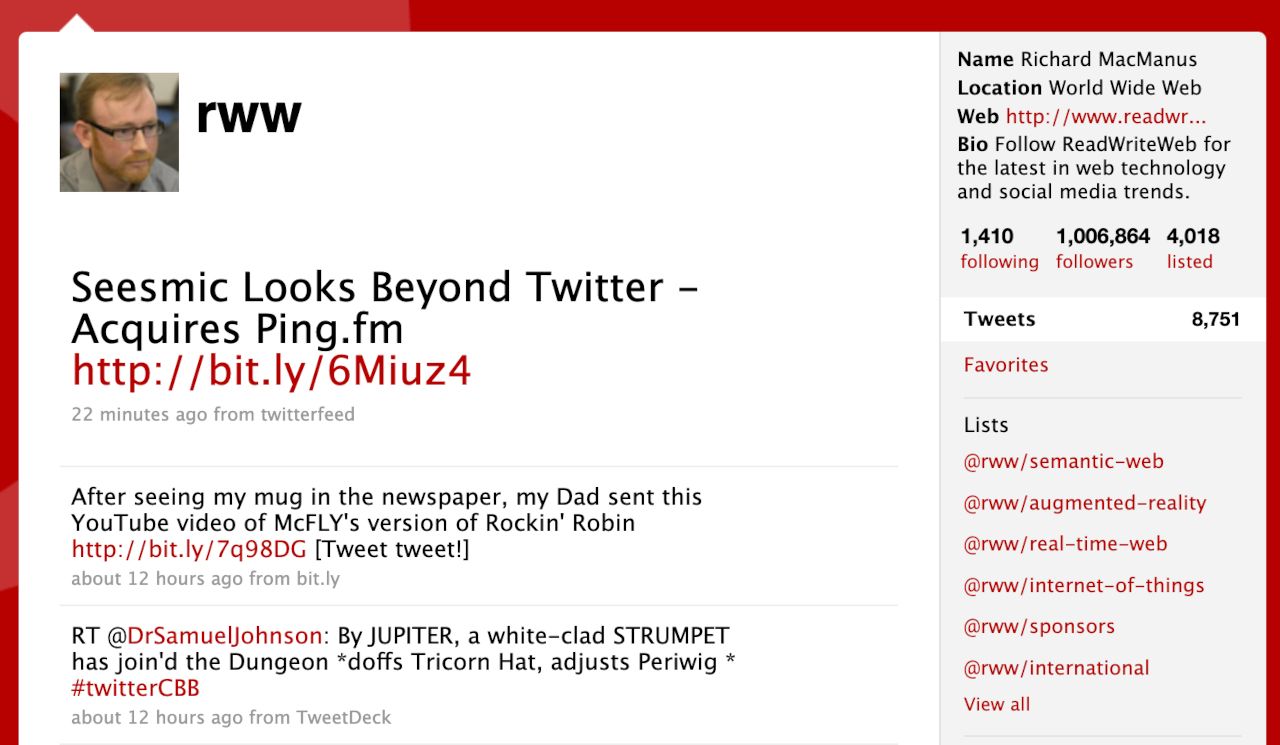
The decision on how our company should use Twitter was complicated by the fact that I had a huge audience on @rww. According to the NZ Herald, I passed the one million mark in Twitter followers on Sunday, January 3, 2010. This apparently made me the 207th most popular person on Twitter, “with more followers than Kevin Rudd, Ben Stiller, Snoop Dogg and Yoko Ono, to name a few.” I was far and away the top kiwi on Twitter—our prime minister at the time, John Key, only had 7,522 followers. I’d been interviewed for this piece but had tried to downplay the milestone because I knew that most of those followers were via Twitter’s SUL (suggested user list).
The hiring of our new community manager in August 2010 finally forced my hand—I decided then to turn over the @rww account to Seamus. The name of the account changed accordingly, from my own to “ReadWriteWeb.”
It was, in retrospect, a terrible decision. Over the coming decade, social media would explode in popularity. Other tech bloggers of my vintage used their large Twitter followings to boost their public profiles over the twenty-teens. I was the odd one out, having given up my SUL privileges in 2010. It also meant that several of my writers ended up with accounts more popular than mine—Marshall, Sarah, Frederic, and others. I completely failed to foresee how important Twitter—and indeed, all social media—would become to personal branding.
Social Referrer Traffic
But my mind wasn’t on personal branding at this time. In August 2010 all I was concerned about was how to increase page views to RWW via social channels. That month, we went over 5 million page views for the first time—over 2.5 million of which were unique visitors. This was helped by a big month on Digg. Both Google search and our Feedburner RSS feeds dwarfed social referrers at this time, but generally our best traffic months were dictated by the swings and spikes in social referrers.
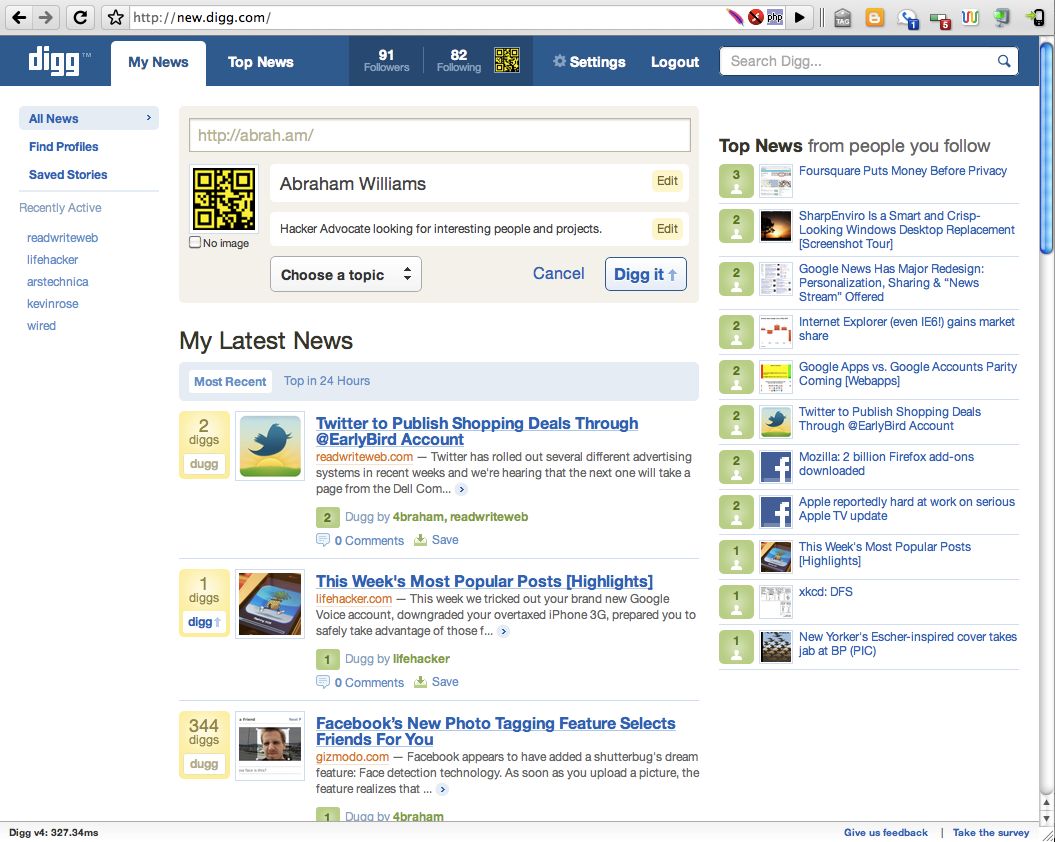
Traffic from Digg, in particular, was wildly inconsistent. We’d gotten over 133,000 page views from it in August, but just 20,000 the month before. As it turned out, August was as good as it would ever get again from Digg—it had launched a controversial redesign at the end of August that saw its power users revolt and its popularity as a tech-news aggregator plummet. By the end of the year we were getting more traffic from Digg’s competitors, Reddit and Hacker News.
Digg’s troubles were exacerbated by the increasing power of Facebook and Twitter as social platforms for publishers like RWW. For the rest of the year, both social networks drove more monthly traffic to RWW than Digg. Indeed, by the end of 2010, Twitter was our top social referrer overall, followed closely by Facebook.
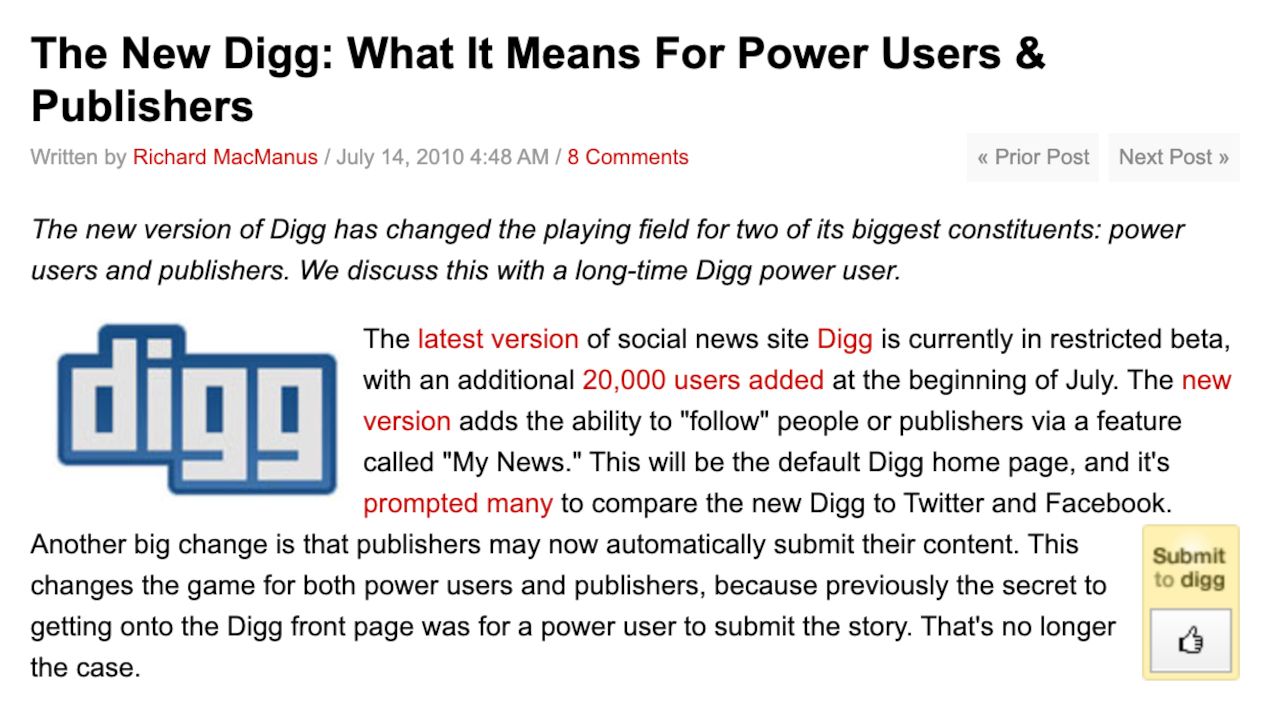
The underrated social referrer for us was StumbleUpon, the rather mysterious app that mimicked the “I’m Feeling Lucky” button on Google’s search front page. Most commonly used as a browser extension on computers, StumbleUpon let you enter a topic and then took you to random related websites. The algorithm was a complete black box to publishers, so there was no gaming of StumbleUpon (unlike Digg). We never knew which of our articles would strike it lucky, but enough of them did that StumbleUpon was one of our top social referrers. However, it too was inconsistent, and there was a noticeable drop in the second half of 2010, especially compared to Facebook, Twitter, and other new forms of social media.
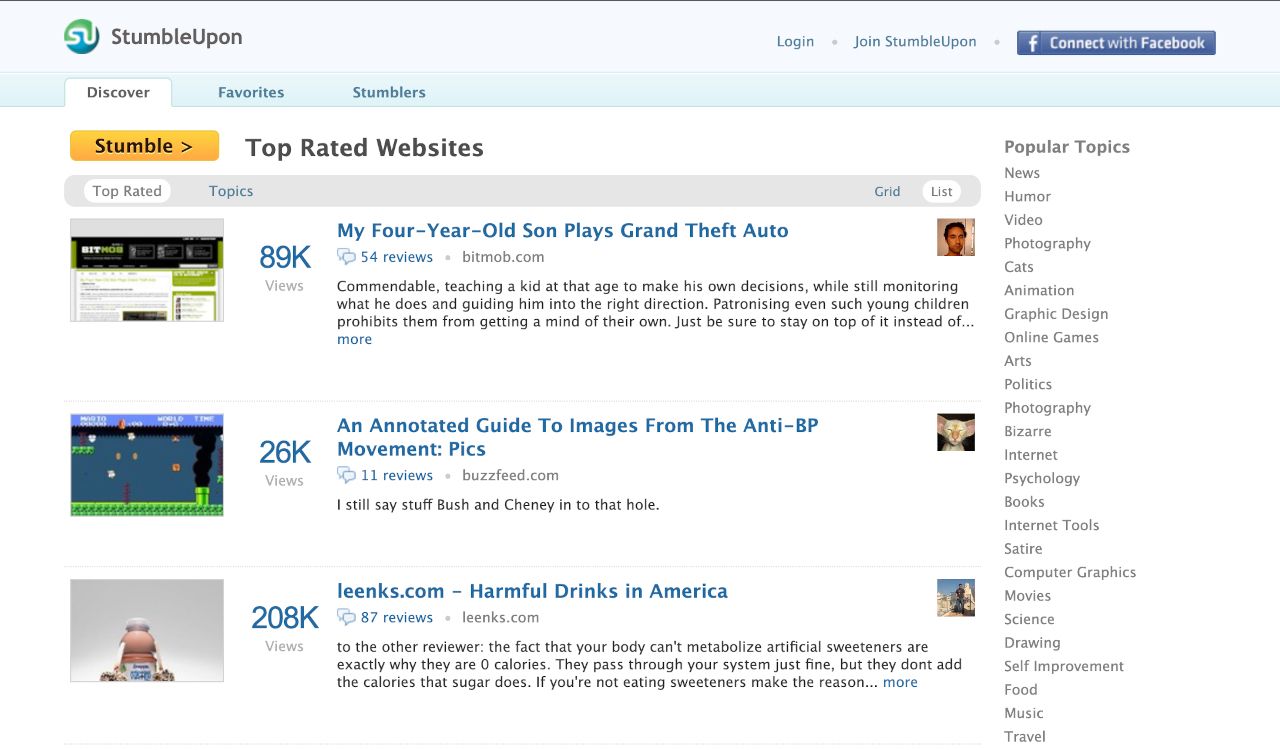
When Seamus took over the @rww Twitter account in August, he also assumed control of our Facebook Page, which had been mostly automated up till that point. We had just under 25,000 Page likes at the end of August, which grew to around 32,000 by the end of the year. Our main competitors were now GigaOm, VentureBeat, and a relatively new European site called The Next Web. We had more Facebook fans than each of them, but we were all a tier below Mashable (370,000) and TechCrunch (120,000) on the social media front.
In December, RWW named Facebook our Best BigCo of 2010. By then, most of my own family used it daily and it was an ever-more-important method for RWW to communicate with our fans via our Page. Facebook was also now the default method for sharing web articles. According to the link-sharing service AddThis, Facebook was selected 44 percent of the time by its users when sharing an article (up from 33 percent the year before). Email was a distant second.
For all these reasons, social media was increasingly important to us—it drove page views, and it increasingly drove online community too.
This post is part of my serialized book, Bubble Blog: From Outsider to Insider in Silicon Valley's Web 2.0 Revolution. View table of contents.
Next up: 055. ReadWriteWeb Growing Pains and Managing the Writing Team
Buy the Book
My Web 2.0 memoir, Bubble Blog: From Outsider to Insider in Silicon Valley's Web 2.0 Revolution, is now available to purchase:
- Paperback, US$19.99: Amazon; Bookshop.org
- eBook, US$9.99: Amazon Kindle Store; Apple Books; Google Play
Or search for "Bubble Blog MacManus" on your local online bookstore.